Finding sides and angles with sine, cosine and tangent
Categories: gcse trigonometry pythagoras
Level:

A triangle, of course, has three sides and three angles. But the sides and angles are related to each other. For example, if we decide to make a triangle with sides of length 2, 3 and 4, then there is only one way to make that triangle. If we choose the side lengths, we cannot choose the angles. This is called the SSS rule of congruent triangles:
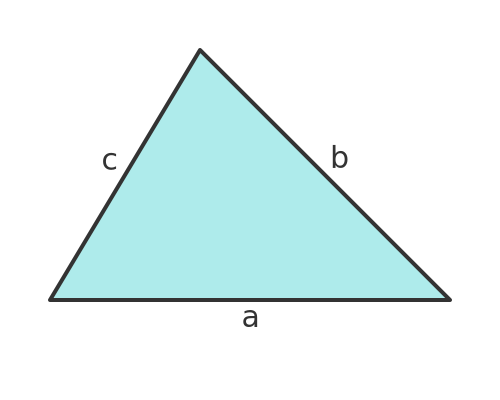
In trigonometry (derived from the Ancient Greek for measuring triangles) we learn about the relationships between the sides and angles. In this article, we will look at the sine, cosine and tangent functions that describe the relationship between the angles and sides of a right-angled triangle.
Naming the sides of a triangle
Here is a right-angled triangle. We have marked one of the angles as x:

The side of a right-angled triangle that is opposite the right angle is called the hypotenuse. The horizontal side that is next to the angle x is called the adjacent side. The other side is called the opposite side - it is opposite the angle x.
The side names depend on which angle we choose. Here is the same triangle, but this time the marked angle is y:
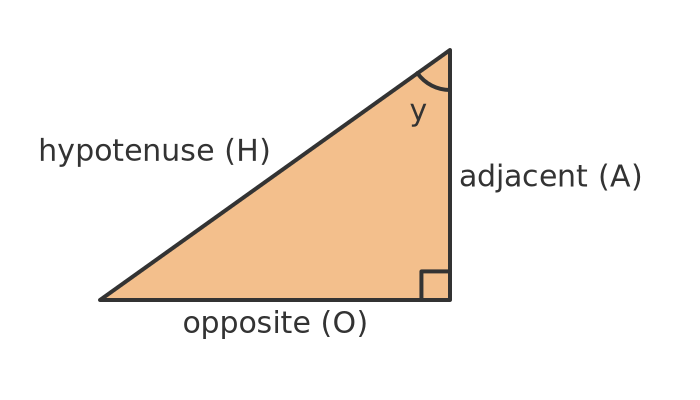
In this case, the adjacent side is the vertical side, because that side is next to the angle y. The opposite side is the horizontal side.
Notice that the hypotenuse is still the same because it is always the longest side that is opposite the right angle.
The sine function
This diagram shows three triangles. Each triangle has a different angle x, but they all have the same hypotenuse H, of length 10:
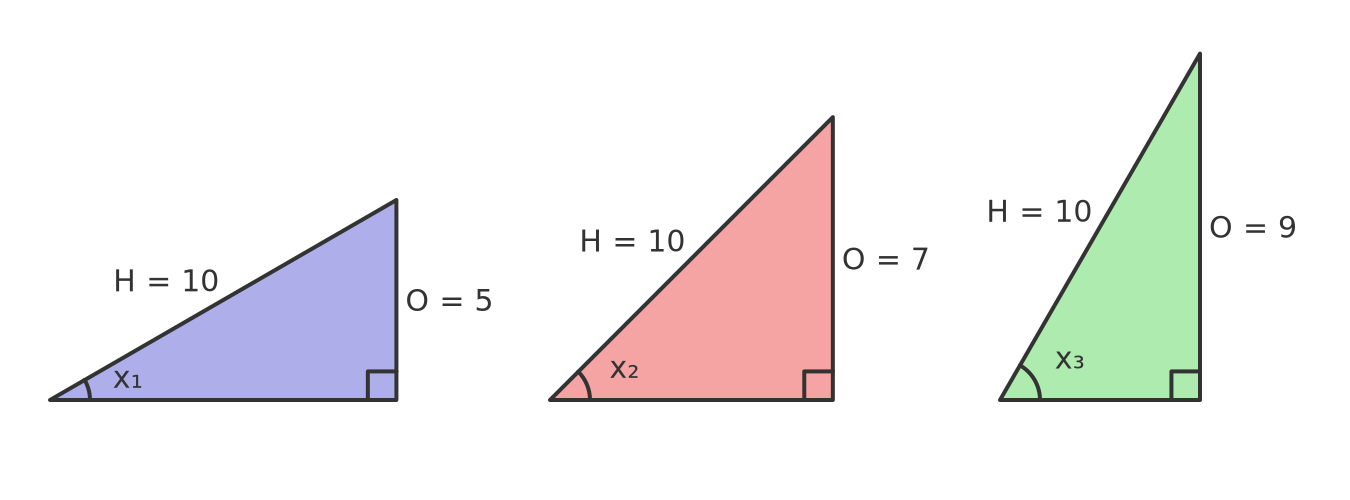
Notice that, for different values of the angle x, the length of the opposite side, O is different. We could say that the length of the opposite side depends on x. Another way to say that O is a function of x.
If we take the first triangle and make larger or smaller copies of it, we can see that O also changes even when x stays the same:
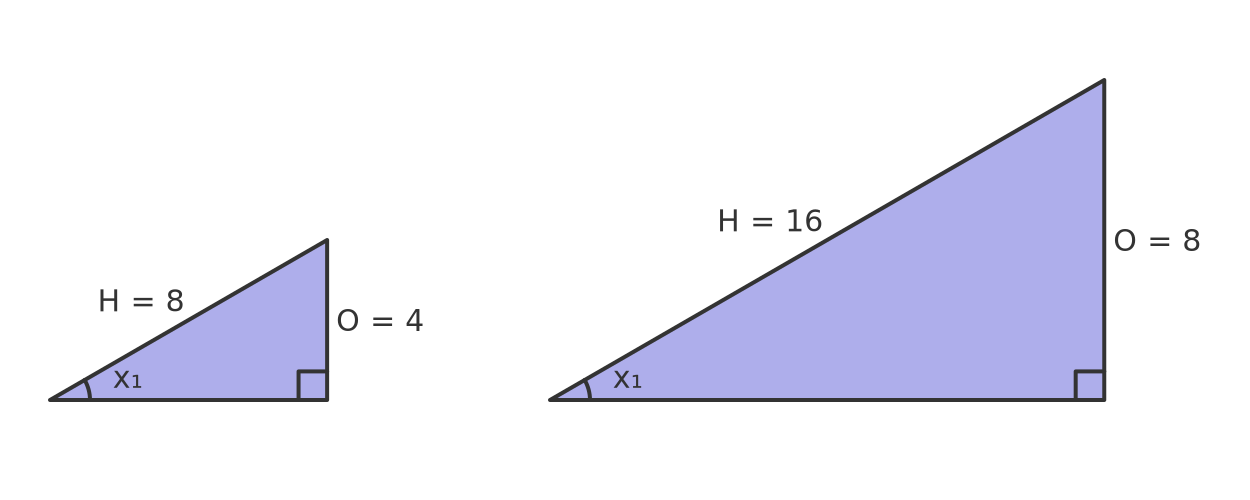
But these two triangles are both similar to the original triangle, which means that they have identical angles and also their sides are in the same proportions. You will notice that for each of the triangles, O divided by H is exactly one-half (5/10 for the original triangle, 4/8 for the smaller triangle, and 8/16 for the bigger triangle).
We can now refine our previous statement, and say that O/H is a function of the angle x. We call this function the sine function, usually abbreviated to sin. So the rule is:
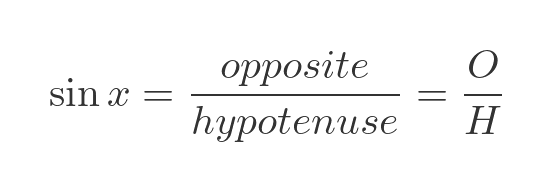
You can use a calculator to find the value of the sine function for any angle x.
Sine examples
We will look at a couple of examples to see how we can use the sine function. First, we would like to find the side x in the following right-angled triangle:
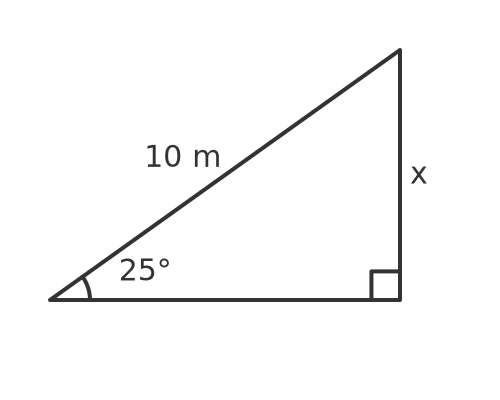
In this example, the angle is 25°, and the hypotenuse has length 10. The side marked x is opposite the angle.
We can put these numbers into our equation for the sine function:
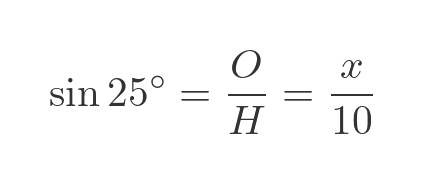
Rearranging this to solve for x we get:

Here we have used a calculator to find the sine of 25°, which is approximately 0.442618. This gives a final result of 4.43 to 3 significant figures.
In this second example we are given two sides and need to find the angle:
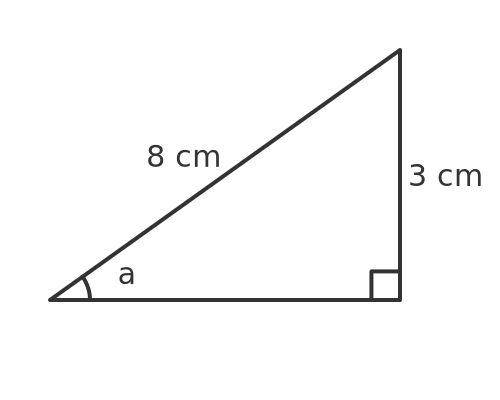
This time we need to find the angle a. The hypotenuse has length 8 cm, and the side opposite the angle has length 3 cm.
We can put the numbers into our equation for the sine function:
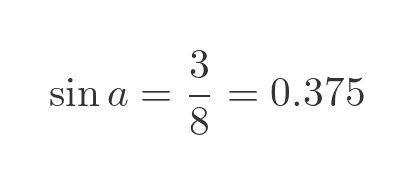
So now we know that the sine of angle a is 0.375, but we need to find the value a. To do this we need to use the inverse sine function. The inverse sine of 0.375 will be the angle a.
The inverse sine is written as sin followed by a raised "-1", like this:

This tells us that the angle is 22.0°, to 3 significant figures.
Your calculator should be able to find the inverse sine. Usually, you will need to press the "inv" button followed by the "sin" button.
The inverse sine function is sometimes called the arcsine, arcsin, or asin function.
The cosine function
This diagram shows another three triangles. Again, each triangle has a different angle x, but they all have the same hypotenuse H, this time of length 12:
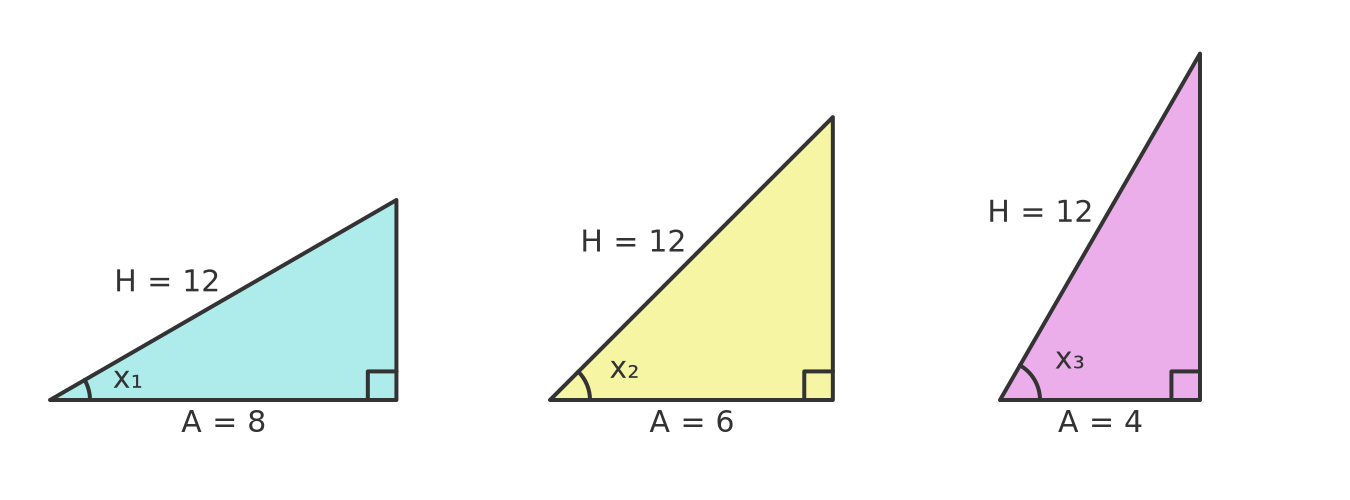
Notice that, for different values of the angle x, the length of the adjacent side, A is different. The length of the adjacent side A is a function of x.
But remember when we looked at the opposite side, we saw that as x increases, the length O increases. This time, when x increases, the length A decreases. So clearly, O and A depend on x in different ways.
If we take the middle triangle and make larger or smaller copies of it, we can see that A also changes even when x stays the same:
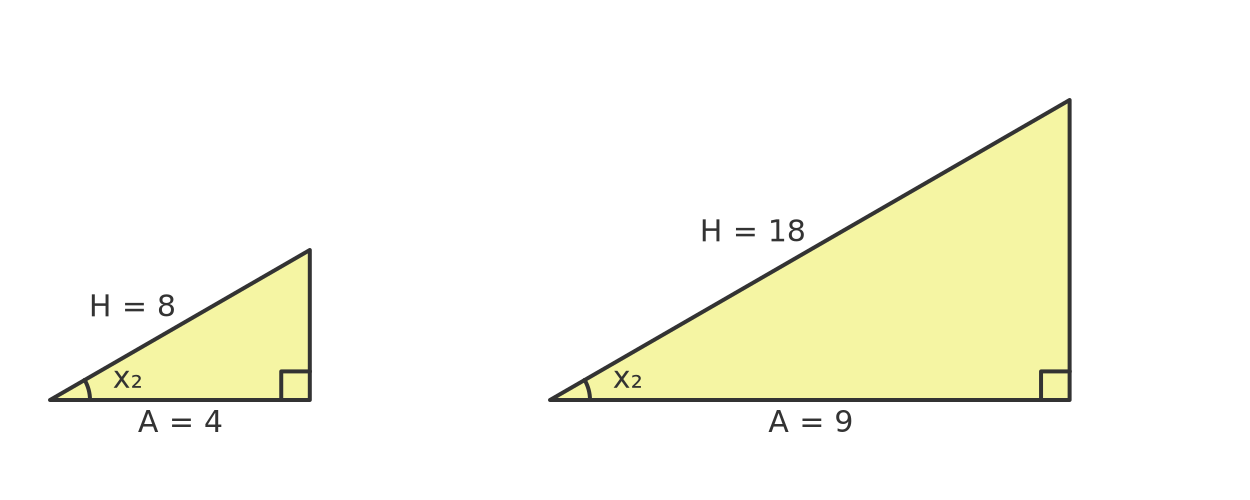
Since these are similar triangles, it tells us that A divided by H is a function of x, but it is a different function from the previous sin function. We call this new function the cosine function, usually abbreviated to cos. So the rule is:

Again you can use a calculator to find the value of the cosine function for any angle x.
Cosine example
The sine function relates the ratio O/H to the angle, and the cosine function relates the ratio A/H to the same angle. So cosine calculations are very similar to the sine calculations above, except we are interested in the adjacent side rather than the opposite side.
As an example, we will look at a slightly different case, where we know the angle and the adjacent side, but we need to find the hypotenuse:
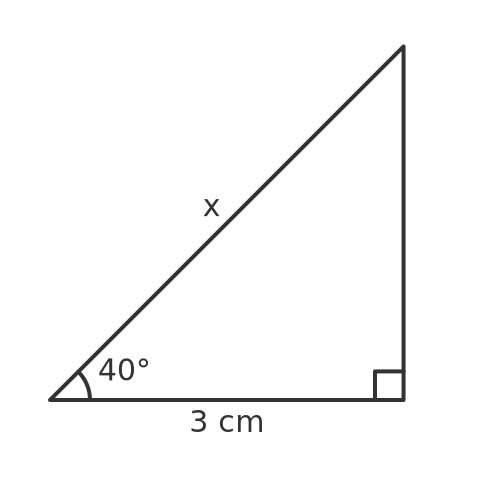
In this example, the angle is 40°, and the adjacent side has length 3 cm. The side marked x is the hypotenuse.
We can put these numbers into our equation for the cosine function:

Rearranging this to solve for x we get:

Again we have used a calculator to find the cosine of 40°, which is approximately 0.766044. This gives a final result of 3.92 cm to 3 significant figures.
The tangent function
Finally, here are three more triangles. This time, each triangle has a different angle x, but they all have the same adjacent side A, of length 10:
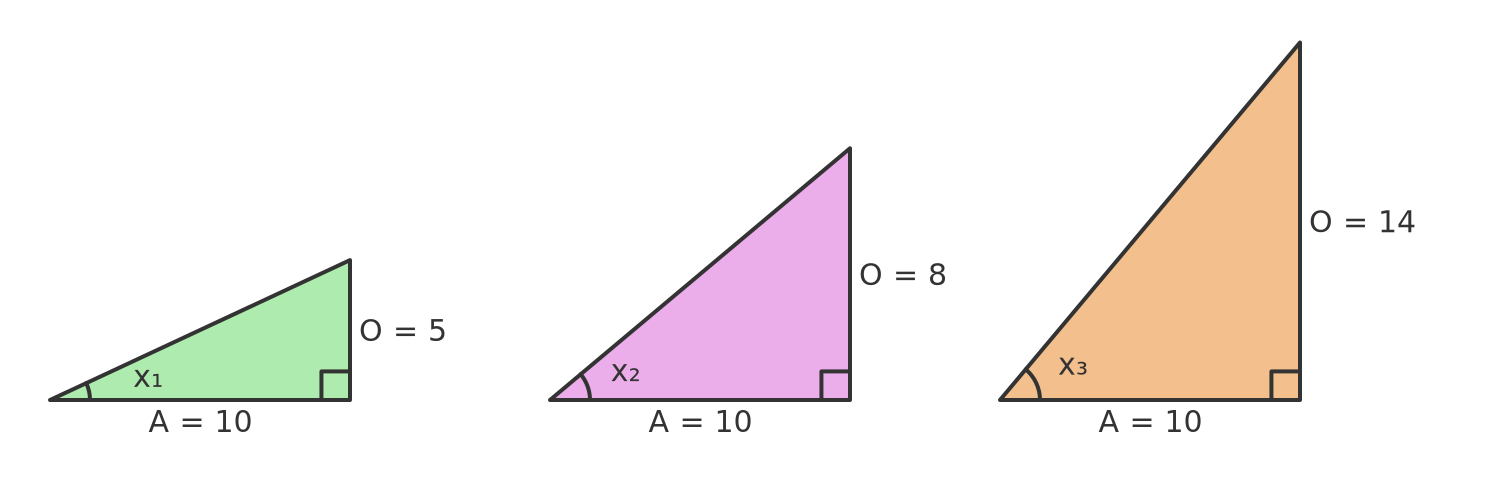
Notice that, for different values of the angle x, the length of the opposite side, O is different. The length of the O is a function of x.
In each case, the length of the adjacent side A remains the same but the length of the hypotenuse changes with x.
If we take the middle triangle and make larger or smaller copies of it, we can see that O also changes even when x stays the same:

Since these are similar triangles, it tells us that O divided by A is a function of x. We call this function the tangent function, usually abbreviated to tan. So the rule is:
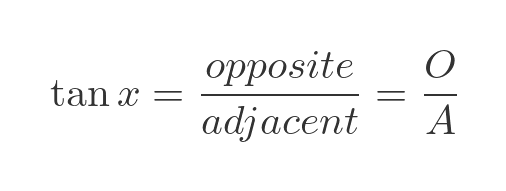
Again you can use a calculator to find the value of the tangent function for any angle x.
Tangent example
The tangent function relates the ratio O/A to the angle. This means, for example, that if we know O and A we can find the angle x:
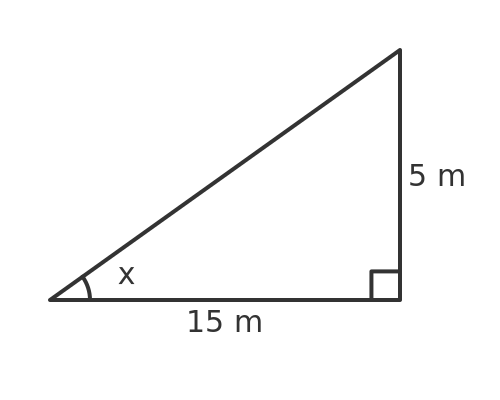
In this example, the A is 15 m and O is 5 m. We want to find the angle x. We can put these numbers into our equation for the tangent function:
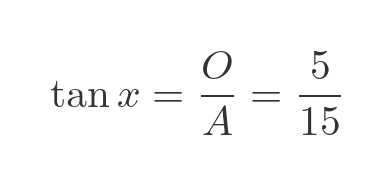
To solve for x we need to use the inverse tangent (in the same way that we used the inverse sine in an earlier example). This gives us:

Again we can use a calculator to find the inverse tangent of 0.333333..., which gives a final result of 18.4° to 3 significant figures.
Remembering the formulas
We have used three important formulas in this article:

We can remember these using the following simple phrase SOH-CAH-TOA. This is pronounced "So Car Toe-a":
- SOH means sine equals opposite over hypotenuse.
- CAH means cosine equals adjacent over hypotenuse.
- TOA means tangent equals opposite over adjacent.
Related articles
Join the GraphicMaths Newsletter
Sign up using this form to receive an email when new content is added to the graphpicmaths or pythoninformer websites:

Popular tags
adder adjacency matrix alu and gate angle answers area argand diagram binary maths cardioid cartesian equation chain rule chord circle cofactor combinations complex modulus complex numbers complex polygon complex power complex root cosh cosine cosine rule countable cpu cube decagon demorgans law derivative determinant diagonal directrix dodecagon e eigenvalue eigenvector ellipse equilateral triangle erf function euclid euler eulers formula eulers identity exercises exponent exponential exterior angle first principles flip-flop focus gabriels horn galileo gamma function gaussian distribution gradient graph hendecagon heptagon heron hexagon hilbert horizontal hyperbola hyperbolic function hyperbolic functions infinity integration integration by parts integration by substitution interior angle inverse function inverse hyperbolic function inverse matrix irrational irrational number irregular polygon isomorphic graph isosceles trapezium isosceles triangle kite koch curve l system lhopitals rule limit line integral locus logarithm maclaurin series major axis matrix matrix algebra mean minor axis n choose r nand gate net newton raphson method nonagon nor gate normal normal distribution not gate octagon or gate parabola parallelogram parametric equation pentagon perimeter permutation matrix permutations pi pi function polar coordinates polynomial power probability probability distribution product rule proof pythagoras proof quadrilateral questions quotient rule radians radius rectangle regular polygon rhombus root sech segment set set-reset flip-flop simpsons rule sine sine rule sinh slope sloping lines solving equations solving triangles square square root squeeze theorem standard curves standard deviation star polygon statistics straight line graphs surface of revolution symmetry tangent tanh transformation transformations translation trapezium triangle turtle graphics uncountable variance vertical volume volume of revolution xnor gate xor gate
